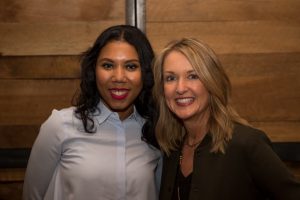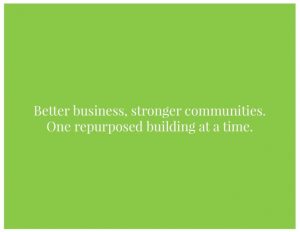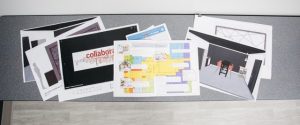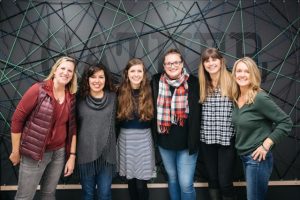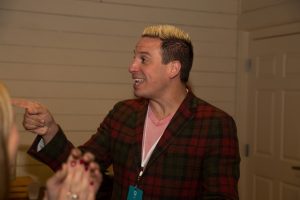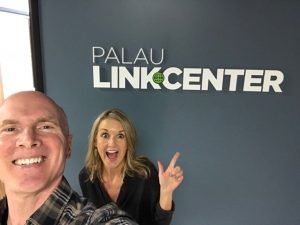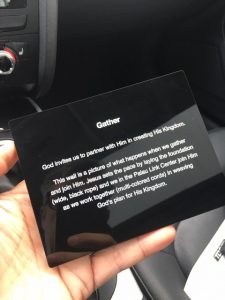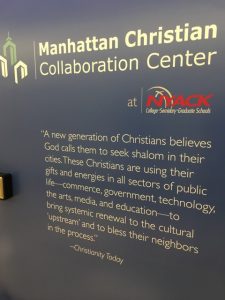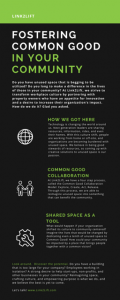S3: Sheri Lozano of Link2Lift #99

Sheri Lozano of Link2Lift
We had some fun jumping over to the west coast to talk with Sheri Lozano of Link2Lift. Sheri discusses her innovative and collaborative idea to use unused spaces for lifting others.
For the full transcript click below
Welcome to episode 99 of the Bonfires of Social Enterprise! Wow-wee, almost at 100. Thanks for your loyal support over all of these past episodes! Oh, by the way, this is Romy, and we had some fun jumping over to the west coast to talk with Sheri Lozano of Link2Lift. Sheri discusses her innovative and collaborative idea to use unused spaces in lifting ways. Be sure to stay until the end for a great song from a Detroit artist!
Now, first, we have to hear what Natalie has come up with for the fun fuel on this episode.
I’m Natalie Hazen and I am bringing you this episode’s Fun Fuel.
Coworking is everywhere. What is coworking you ask? It is a work trend bringing together professionals from across all industries to form inter-connected communities. According to the website, Mindspace, the concept of a coworking space started in 1995 Berlin with 17 computer enthusiasts got together in a facility to create a space where people with an interest in computers could gather to collaborate and work in an open environment.
Fast track to 1999 New York City and 42 West 24 opened to offer a work environment with flexible membership options for teams and individuals seeking a workspace. The difference here was that there seldom were any organized community events.
In 2005, Brad Neuberg from San Francisco launched the first official co-working space originally referred to as a “9 to 5 group.” It was a was not a huge hit at first as no one showed up for the first month, but soon interest sparked and coworking took off.
Coworking leads to great collaboration. When I hear the word collaboration, my mind goes to the lyrics of Vanilla Ice’s 1990 release of Ice Ice Baby. I hear collaboration and I then start singing: stop, collaborate and listen and then goes on to say, “if there was a problem, yo, I’ll solve it.” Makes me smile every time.
Let’s jump on over to see who Romy is collaborating with on in this episode and what problem they are solving.
Okay, I absolutely love Natalie’s fun fuels! That was so interesting about co-working spaces! And, now I have the Vanilla Ice song in my head! Ha Ha. I have to look that up next! What a perfect lead into a collaboration that Sheri Lozano has tackled with Link2Lift. Let’s drop in on my conversation with Sheri…
Romy: Sheri, why don’t you give us the background about what Link2Lift is?
Sheri: Link2Lift is a company that we developed in response to underutilized space. It seems like we’ve had a ton of buildings that are left unused, and we’ve developed a process where we can create co-working communities but with a purpose.
Voice: Let’s talk about how you got inspired first just to get everyone caught up to what originally lit your fire if you will.
Sheri: You know, it’s interesting because I never intended to develop a business. It was more a response to an experience that I had as a volunteer going back and forth to international … as a volunteer doing international work with communities and then coming back to America, which is so rich, and realizing that we have needs here. And how come with all of the wealth that we have in our own county, we still have people in need?
And so, I just started to be a little curious, and we talk about collaboration, that we have resources, and are we really collaborating? Are we really using our resources well to help our communities that are in the minor, and it was amazing to me that I could go into a Third World country under-resourced with 25 people from the U.S. I’ve never met before and go into a community where I didn’t speak the language, and we could somehow see 700 patients a day. Or we could see high volume, and we could work together.
So, in America, as I started to research this, it was more just out of curiosity. What I found was amazing. There’s a lot of people that want to do a lot of great things, but I wasn’t happy with the way I saw collaboration working, and I just thought, “We could do better.”
Romy: And, Sheri, what did you find some of the main key barriers or maybe just all out fail points that were reoccurring from what you were observing? Why it wasn’t working?
Sheri: Yeah, what was interesting, the pain points usually were really out of people wanting to do good. It wasn’t a matter of people not wanting to spend their money or give or people not having heart to do well. It was truly just a lot of repeated work, a lot of overlap, a lot of people not realizing that there is something much like their great idea just down the street or next door.
I did this kind of boots on the ground. I decided I … of course, attended conferences and listened to think partners, but I also decided to do just boots on the ground. And by doing boots on the ground, I could walk with each different sector with channels of influence and see what they were experiencing, and then, I would take copious notes.
So, I could walk with the family who was being cared for. I could walk with the city official. I could walk with the faith community and an investor and take notes, and what I noticed was that there was a lot of duplicate effort, and I felt like that was the one takeaway. I have to be a part of solving this problem, the duplicate effort.
Romy: You hit on a lot of points. It was the faith community, perhaps the government or civic, and then, the beneficiary. It might be a family or a person, and then, what else did you say in there because the faith community, government, and maybe the family or social mission beneficiary and …
Sheri: And the non-profit [crosstalk].
Romy: And the non-profit, okay. Okay, yeah. So, you’ve got this discovery because I think that a lot of us acknowledge that that is happening. How did the different groups respond when you started to highlight some of this overlap? Were they defensive, or were they openly looking for a solution?
Sheri: That’s a good question. I think it comes with a mixed response because a lot of people, I’m sure, felt the same thing. This was not a new revelation to them, but they’re weary, right?
Romy: Mm-hmm (affirmative).
Sheri: It’s like, how do you make time to collaborate well? So the good thing was coming in as a neutral convener, coming in with the heart that I just want to help make this better, and I wasn’t trying to change the identity of each of the organizations and what they have to bring or even how they want to do it.
I was just trying to find where are the common points so that we can really reduce overhead. We can reduce duplicate efforts and increase our impact, and people responded really well to that.
Romy: Yeah, I bet. Weary, I feel is an operative word there. You can see a solution, but when you’re just so tired, and you’re just trying to get to that very next step, changing it even for the better sometimes can feel overwhelming, you know?
Sheri: Mm-hmm (affirmative). Mm-hmm (affirmative).
Romy: Yeah. We do have a lot of …
Sheri: And the good thing is, at that-
Romy: Oh, I’m sorry. I talked over you by accident. Go ahead.
Sheri: That’s okay. The good thing is at that point; you have to keep in mind that I was still on my curious journey. So, at that point, I wasn’t coming in as a business, I wasn’t, or even a non-profit or a program. I was coming in asking questions.
So, it seemed like for the first time, maybe why I gained some favor in the research was because I really was curious. I did not come with answers. I came to create a conversation, and I think that was really refreshing for the people who at least I spoke with.
Romy: Yeah. And then now, it’s fully turned in to a physical space as of last week, right, June of 2018, right?
Sheri: Link2Lift?
Romy: Yes.
Sheri: Okay, well, so what I do is my client has physical space, so in this curious journey, what I realized was space played a role in collaboration. All these people who had weary work and were working in isolation, many times when you get them in the same room, they’re more than happy to work together.
So, when I identified space played a role in collaboration, and yet almost every time I had a meeting, I was meeting in these big buildings that were empty, and it just … I found irony in it. So, yeah, we turned the idea, all the research from 2013 to two thousand … really ’15, ’16. I turned it into, “Okay, how can we repurpose tools that are right at our fingertips?”
A lot of these people have access to buildings, and co-working is not a new idea, but what if we applied co-working a little more intentionally and either the client as a business person who would like to build an accelerator or use technology to your advantage. But what if we dedicate a tenth of that to this non-profit collaboration?
And so, in doing so, I’ve been able to run this model of how we can do that in almost any space, and it seems to be catching on. You’re right. Last week, we opened the first center that completely went through all four stages of our company, and it’s the Palau LinkCenter in Portland, Oregon.
And what’s fantastic about it is it’s a co-working space but with a purpose, and so, these tenant partners, they have their own identity. They have their own organization, and yet, they have intentional time where they will connect with one another, do strategic planning.
The co-working space, the Palau LinkCenter will become a strategic asset. It’s almost like I have to be there at least once or twice a week, or I’m going to miss something. I would say that would be the element that’s a little bit different than the trend-on co-working style, which is great. But Link2Lift, we’re committed toward a little bit more intentional sense of community and purpose in how the workflow is in the space.
Romy: And for just as a side note, let’s give them their website in case they want to look at some of the pictures while you’re talking here.
Sheri: It’ll be PalauLinkCenter.org.
Romy: And let’s spell that for them.
Sheri: P-A-L-A-U-L-I-N-K [inaudible]C-E-N-T-E-R.org.
Romy: Okay, perfect. Perfect, perfect. And there’s a lot of pictures on the Link2Lift.com website, and that’s www L-I-N-K2? The number 2? L-I-F, as in Frank, T as in Tom dot com. All right, so just a little sidestep there. If they want to just tune into your pictures while you’re telling this great story. So let’s talk about your program, The Common Good. Its Common Good Collaboration Model? Is that the full name of your program?
Sheri: Yeah. For short, we call it The Common Good Collaborator, but it’s a process, and so yeah, they model. It’s a process of four stages. I like to go in with my client and ask a lot of questions. Usually, people have come to me because they’ve heard that I can help reimagine their space. It’s interesting the amount of people who have this dilemma now. You look at retailers; you look at the commercial property, church buildings, faith communities, it’s kind of a dilemma. What do we do? Now that technology has allowed us to do so much remotely, it’s changed the consumer, how they think. So, when people approach me, they usually have an idea that they would like to impact their community. Whether it’s through jobs or some other way. And so that first process is really important where I just ask a lot of really good questions. Because I believe that property owners have to really resonate with the community that they attract, you know the co-working space they attract. So, whatever it is they care about, we’re gonna build something under that umbrella. I think it’s the highest chance of sustainability when the owner’s really behind it.
We explore all the options of what that can look like, and to be honest with you, this is like the funnest part because I approach the common good collaborator like a city. Imagine a thriving city and what it takes to have a thriving city, and a post office, and a gas station, and a market, and work, and so I put that into a building, and so we have a lot of fun learning what would create a thriving community in your building, and what kind of community do you want that to look like. What kind of culture, who do you wanna impact as a result? And that’s really the fun part, and then we get to create it. Have a network of people that we can bring into the conversation.
I love using local talent. I think everyone who lives in town could be a part of building this space, architect’s design if there is a budget for that. If not, there are a lot of people that are very creative, and they can repurpose space. But, if the property owner or my client really feels like they want me to bring in the talent like you have that and we can definitely consult on that. And then we go through just this release phase where we say to the client, “Hopefully we have helped create a co-working or shared space environment that a portion, at least a portion of it, is dedicated through common good to create greater impact. And here is the strategic plan for the next 12 months.”
And then we check in with them, and we help develop that shape, that culture of the community because it is gonna require a new muscle memory than the way people have worked before. Because remember, the way we worked before was very much in silos and very much caused weariness and duplication of effort. But, in that same weariness in the new environment, there’s this temptation to go back to this old muscle memory. And so, in the release phase, I really like to stick with the client for the first 12 months and make sure they have a good plan on how to create some new muscle.
Romy: Yeah, that’s a great word, muscle memory. Even though it’s good for us, we can default back to old things, especially in stressful environments or when challenged. So then is there one more phase after that?
Sheri: Yeah, there’s four phases. Explore, create, act, and release. I’m sorry, I skipped overact.
Sheri: I’m sorry, yes. Explore, create, act. Act is when we actually, we’re doing it. We’re doing everything. We’ve explored, we’ve created, talked about. Were in action, and then there’s release.
Romy: Okay gotcha. All right, so that’s great. Do some discovery, come up with it, put it into place, and then kind of, I’d say put it ongoing monitoring of it all, but I like your word release. Because that’s probably the truth of what happens. Well that’s great so what, and you bring up things like churches and that, you’re in Portland, I’m in Detroit, and we have just an abundance of abandoned buildings, but including churches. And when you first brought that up when we first started talking, I was like, “Oh, yeah, that is a better way, because I don’t think about the faith-based organizations that are … have less bodies in them then they used to, and all of those things. Let’s pick out one of those. Has there a church project or a faith-based project that you have started to work on, and were they receptive to open their doors for collaborative space?
Sheri: Yeah, I think churches are definitely asking the question, “What can we do?” A lot of them are doing a great job in opening their doors. As a matter of fact, the irony of everything is in my research, the very first project I worked on was with a church. And what I’m finding with churches is, a lot of time they need to kind of reorganize how they use their own space, even from their own organization. So, for this particular church, we went in and just reorganized how their staff functioned. We put their staff in a collaborative space, and they become more collaborative, and so it seemed like almost that created this domino effect for how the church functioned. It’s really super fun to see now, four years later, that it really did have … it moved that culture completely. I like to think a good part of it was just how they had to function, even within their staff.
There are other churches that are doing such a great job that I haven’t been a part of, but I’ve created partnerships with, but even before me, there was one in Cincinnati, and these are business people who came together and said, “We wanna build an accelerator.” We’re using our emcee foyer space for startups just to come and drop in an office. And then they realized there was a pool of mentor style business people in their faith community, who could actually give back to these startups. Mentorship started to happen, and the next thing you know, they’re doing this accelerator that is thriving. They’re doing great, great, work.
And I know, that people are applying from all over the US to go into their accelerator program, and so there is this impact that’s beyond their community. It’s around the United States because hopefully, the people who graduate from that program will then take that back to their state, and take their business. And hopefully, their business will thrive as a result of their experience there. That’s that accelerator called Ocean, in Cincinnati.
Romy: And transitioning just a little bit here. Your hubby is a partner. Is he your full partner, or has he just been kind of looped in as you were, or was he part of this decision initially? I mean our think our spouses always end up whether they like it or not, they end up involved to some extent, but how did that come to be, his involvement?
Sheri: Of course. Yeah, Sergio is, he’s an amazing first human, and I enjoy … we work really well together. He’s creative. He’s a designer at Nike, and so because of him, I really believe he’s kind of, over 27 years, he’s really developed the creative side of me. And so, when we interspace, he is a co-founder. He did all of the research, every one of the trips, research trips, he was a part of. We would go and interview people. I would say, the non-profit work I did, boots on the ground, a lot of that particular work he couldn’t do, because he was at Nike. He’s a director there. But, the beautiful thing is, we complement each other.
So, a couple years ago when I walk into a historic home in Nashville, and the building is historic, but it used to be used as a medical facility. Immediately as a creator, his brain sees and designs things on the spot. And the story that could be told of the medical building that now is healing communities that feel broken and how can we create that story and its just super fun to work with him. I’m the principal, I do the consulting work because I don’t already have a full-time job, but he has a heavy influence on the design, they all that things can be, and then even in the community of people that I can refer to, to ask questions and bring on some projects. Super fun.
Romy: Yeah, well that’s exciting. It’s always better to have partnerships in all ways, right?
Sheri: Yes, it is. It is. It’s really good.
Romy: So, what’s on the horizon for Link2Lift as you see, it’s hard to project into the future, but sometimes there’s a truth of what we all see at this moment. I call it the truth of the moment. If you could dream out with the fact pattern that you see forming right now with Link2Lift, what could this grow into or what do you envision for your company?
Sheri: That’s a good question because I believe in the vision I have is probably two-fold. Of course, I have, I wanna say it leads with a vision, but I would like to see every shared space in the United States have a portion dedicated to common good. And so that part of my vision is led by the heart. I believe economic development is great. We can create jobs. There is a reason why people can’t get to work sometimes. And having a portion of every space dedicated towards that nonprofit collaboration, I think will help prepare and equip people to jump those hurdles, so that they can work and do the things that are gonna impact communities in a positive way.
So that’s like the big ask. Every day, we kind of filter through my part of that story. And then on the horizon, practically speaking-
Sheri: Then on the horizon, practically speaking, I think this is a conservative number. There’s 27 million square feet of shared space reported just this year, I have a lot of space I can work with, so forecasting vision, we are developing a DIY toolkit so that the common good collaborator can get in the hands of people who don’t have a budget. Inspiring people, we have colleges, commercial properties, economic developers inviting us into the conversation saying, “Okay, help be a think partner.” Which is very exciting.
That’s enough to keep me busy right there, of course, you look at getting written materials out into people’s hands so right away they can take a couple steps into getting the right people into a conversation.
Romy: Yeah, and that’s powerful. And just to clarify for the listening audience, Sheri will you define this term shared space? Because I think everyone might be swinging from an empty space to a space that’s occupied by maybe a corporation or a church that has a little-unused area, or is it already a co-working space? Would you define from your perspective shared space, what you mean when you say that?
Sheri: I’m so glad you asked me that question because when I use the word “co-working space” there’s kind of this identity that is tied with that. And part of what I feel I’m called to do is to help people re-think the space around them, so if every one of us just today in our actions today, we looked around, we would find space that could be shared and we would not have thought of it as a potential for a collaborative space. So, I’m using the word share space to catch people’s attention.
A shared space could be a retail mall where the developer needs to rethink how that space works. It could be an old high school in Detroit; it can be an old warehouse, I mean US digital has a commercial property where it was an old warehouse that when the owner, David Mcdorf thought about his space, he realized he could dedicate this entire warehouse. And now there’s 48 non-profits that co-work in Vancouver Washington.
So, you know shared space is anything that can be shared, there’s a gentleman in Oregon that has these four desks, but they were four unused desks and so he has a very small, but I believe mighty co-working space and so shared space is anything where thanks to technology, it’s being underutilized. And has potential to be shared.
Romy: Okay, so I just wanted to push on that, thank you for that because when you say the 27 million square feet that could be potential space that’s not used yet that you could get busy helping others reconnect as human beings, right?
Sheri: Right, and I believe that data came out in February and that data is so conservative. I believe that stat is completely, it’s only 20 major cities in the United States, and it’s probably focusing on literal co-working space, co-maker space, you know, spaces that are really clearly defined already as co-working, so in my mind if we took a tenth of those that are already defined, imagine all of those that are not already defined. I mean this is really the biggest asset we have, even over cash is this space.
Romy: Yeah. Well, and it’s a huge resource and it’s interesting that you can default to doing things with technology as business people and working virtually but it causes this separation, of course, and isolation and I don’t know how you’d make some argument for this, but there’s just some sort of argument in my Romy opinion only that when you get people together with eyeball time, there’s just something precious that happens with that eyeball time together that you can collaborate better. You and I right now, we’re talking over the phone, I’d rather be in person with you because I feel like this interview would be so much richer.
Sheri: Right.
Romy: But we’re not able to do that at this second, but hopefully soon. My point is is that there’s just something that happens, and I don’t know how you quantify or measure that resource of in-person time, but there’s something incredible that happens when people are together, and often I just feel that whatever that measure is, and maybe it’s undefined, that is minimized as a treasure or as a resource, and so I don’t know, just throwing out my Romy thoughts into the mix there, but it’s precious.
Sheri: Right, and you’re onto something there because one thing I wrote, you know you can imagine I have these notebooks of writings and one thing I wrote, the irony of everything, what you just said is that technology gave us freedom. Technology took us out of the building. I can work in a coffee shop, I can work on vacation, which I shouldn’t, but I can work anywhere, and I can have a virtual assistant who lives in Alabama even though I’m in Portland, Oregon.
But we as human beings have a need to be in community, which is very interesting, so we emptied our buildings, and now we’re refilling them, but we’re reordering how we use them. Right?
Romy: Right, right.
Sheri: The irony of it is that we wanted to be cut loose to do our own thing, but we realize when I’m only by myself, I don’t have as much impact. And my business can’t thrive ultimately, I have to have face to face time. So what I believe these shared spaces do is they’re kinda the best of both worlds, they give us the opportunity to take advantage of technology, to thrive in new ways, but we have to respond likewise to being in community in new ways.
Romy: Yeah.
Sheri: And to be very honest, the next generation leader, the millennial, the Gen Z, this is the only way they’ve ever known. This is how they grew up.
Romy: Right, right.
Sheri: And so, if we don’t respond in the same way, then we kind of ask ourselves, “Will our businesses sustain? Will that thing that we care about sustain the next ten to fifteen years if the next generation leader thinks completely different and their workflow is different?” I feel like we’re at this point where we have to address our workflow, it can’t just be all in our buildings, and it can’t just be all remote with technology, there has to be kind of a merger where we get a fair amount of face to face and a fair amount of freedom.
Romy: Yeah, that’s well said I feel like this is really the exciting part about what you’re doing innovating and designing in this space, and you have the benefit of being in a place of observation as you bring people together in these collaborative ways cause you get to see it happening live. And be our thought leader and tell the rest of us how it’s going. That’s so great. I really appreciate it.
Sheri: Yeah, we’re still so young, we’re just getting started. We have so much to learn, so thank you for being the Romy for being the microphone really.
Romy: Well, I think we’re all learning how to fly the plane while we build it while it’s in the air. It’s just the nature of what’s going on right now, again exciting and terrifying and wonderful all wrapped up into one. Well, how would others reach out to you, let’s give them the website again and any other social media, any potential contact information?
Sheri: Yeah, I would say the website is the best, link2lift.com, it’s l In k, number two, l I ft dot com. The reason I say that is because you can fill out an interest form and it’ll get to my team, and that’s really the best way you can schedule a 30-minute complementary time where we can just talk about what it is that you are interested in. I would say also fun things are just following us on Instagram because you get to see pictures, Linkedin of course, articles, Medium writing articles. So just keying in Link2lift is the best way to stay connected with my team.
Romy: Yeah, all right, well perfect, thank you so much Sheri, and we look to stay in the loop with you and follow your progress from season to season and keep learning from you. And hey, to our listeners we’re gonna put lots of these links in the show notes so we’ll put some additional links that Sheri’s provided for us to videos and other resources for you. So, thanks again Sheri and we’ll follow up soon.
Sheri: Thank you, Romy, it was my pleasure.
Well, thanks a bunch Sheri for all of your transparency and big dreams. Okay, its that time again! Time for some music from Detroit! This music is provided to us courtesy of our friends at Assemble Sound in Detroit. Here are the Infatuations and their song ‘Blame it on You.’ Enjoy this great song and until next time, keep those bonfires burning!
Websites for Link2Lift
Websites for Sheri Lozano
More Links
Jump over to the website for the podcast at www.bonfiresofsocialenterprise.com
Give us a question to the mailbag!
Find us on Facebook and Twitter @bonfirespodcast
Find out more about Gingras Global at www.gingrasglobal.com and www.gingrasglobalgroups.com and Facebook of Gingras Global and Twitter @gingrasglobal



